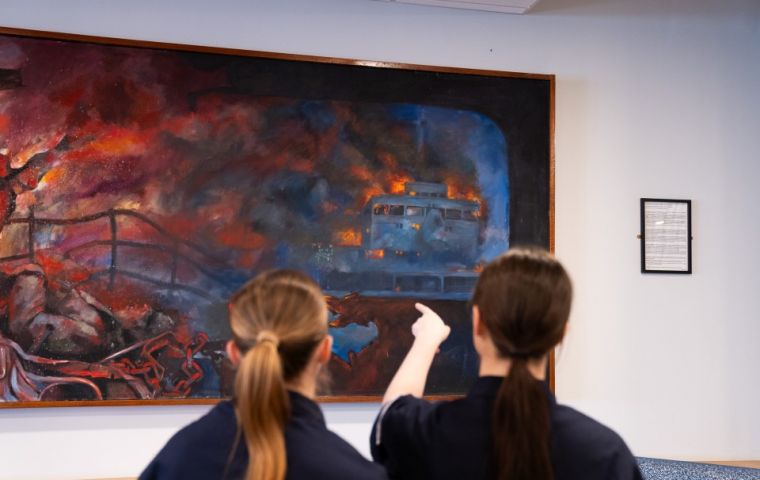MercoPress. South Atlantic News Agency
United Kingdom launches search to find the artist of a striking Falklands painting
 The artwork shows a graphic scene from the Bluff Cove Air Attacks during the Falklands War. (MOD Crown Copyright)
The artwork shows a graphic scene from the Bluff Cove Air Attacks during the Falklands War. (MOD Crown Copyright) A search has been launched by the DIO for the artist of a striking painting that depicts the brutal reality of the Falklands War. The picture was found in a former classroom at HMS Raleigh by a staff member who works for the Defence Infrastructure Organization (DIO). With the classroom not currently in use, the painting had been all but forgotten about.
A key part of DIO’s role is to maintain the Defense estate and ensure that Ministry of Defense (MOD) buildings are able to support armed forces personnel.
The painting was found in Building 110, affectionately known as the Fieldhouse block - named after Admiral Fieldhouse, who led the retaking of the Falkland Islands.
The artwork shows a graphic scene from the Bluff Cove Air Attacks during the Falklands War. The far right of the image is thought to show a burning RFA Sir Galahad during the attack, which saw the greatest loss of British life throughout the entire conflict. A total of 56 British personnel were killed in the attack, with 48 of these perishing following the bombing of RFA Sir Galahad.
Following its discovery, the painting has prompted discussions and questions about who could have been behind its conception. It is currently not known who could have created the artwork or if they were present during the conflict.
Jon Rickman-Dawson, DIO Facilities Manager at HMS Raleigh, who found the painting, said: “As part of my role looking after the built estate, I went into a disused building while demolition work was happening nearby to check the building was still in good condition.
”I walked into what was a classroom and, on the wall, I noticed a very unusual piece of artwork. I took photos of it and started to ask questions to people who have worked on the site for a long time as to what they knew about it and what it is of.
“My hope is that someone will see the picture and it will make them remember something. It would be great to credit someone; other sites have so much history, they might have great gold-framed oil canvases, but we have got this.”
The painting, which measures 20ft by 6ft, now sits in the Trainees’ Bar at HMS Raleigh where it can be seen by those training at the base, as well as by their families visiting for Passing Out ceremonies. It has now become a piece of history at HMS Raleigh that staff and recruits can enjoy together, while learning about the conflict and the realities of war.
Before it took up its new home, the painting was refurbished by a team known as the ‘Buffers’. The team cleaned, re-stained and treated the frame before installing it in the bar.
Mark Eve served as a Chief Petty Officer in the Royal Navy during the Falklands War, and worked on an ambulance ship helping those injured in the Bluff Cove attacks. He said: “I’ll be honest, the first time I saw the painting, it got me very emotional. There are things in the painting that I can see, but nobody else can, but then when other veterans have looked at it, they see what I see. That’s the marvelous effect it has on you. It’s a little bit abstract in some respects, but it encapsulates everything about the Falklands conflict.
”Not only does this painting make me emotional, it also makes me immensely proud of what I did during that time. It was my duty, but I am still proud of what we all achieved“.
Mr Eve served on HMS Hecla, which was used as an ambulance ship during the Falklands War, transporting casualties from both sides to SS Uganda.
Base commander at HMS Raleigh, Sean Brady, said: ”What we want is to find who the artist is, where they are now and what they were trying to show with this painting.
“I thought the artist was trying to show the reality of what happens in conflict and this picture shows it really well.”
The artwork is believed to have been painted between 1982 and 2010, and it is very likely by somebody who was there on the day of the air attacks, due to its level of detail and the emotion it stirs up for veterans.
Anybody who knows who may have painted the artwork is urged to get in touch with DIO by emailing dio-corporatecomms@mod.gov.uk, or via our social media channels.




Top Comments
Disclaimer & comment rules-

Read all commentsThat is a very intense and moving painting...
Jan 07th, 2024 - 04:31 am 0Commenting for this story is now closed.
If you have a Facebook account, become a fan and comment on our Facebook Page!